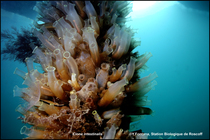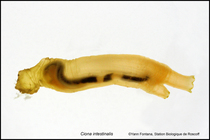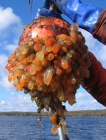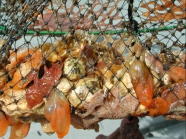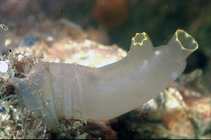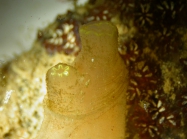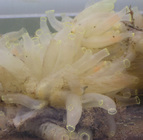
| Intro | | Search taxa | | Browse taxa | | Distributions | | Terminology | | References | | Statistics | | Online sources | | Tutorial | | Log in |
WoRMS taxon detailsCiona intestinalis (Linnaeus, 1767)
103732 (urn:lsid:marinespecies.org:taxname:103732)
accepted
Species
Ascidia canina Mueller, 1776 · unaccepted (original combination)
Ascidia corrugata Müller, 1776 · unaccepted (original combination)
Ascidia diaphanea Quoy & Gaimard, 1834 · unaccepted (original combination)
Ascidia intestinalis Linnaeus, 1767 · unaccepted (original combination)
Ascidia membranosa Renier, 1807 · unaccepted (original combination)
Ascidia ocellata Agassiz, 1850 · unaccepted (original combination)
Ascidia pulchella Alder, 1863 · unaccepted (original combination)
Ascidia tenella Stimpson, 1852 · unaccepted (original combination)
Ascidia virens Fabricius, 1779 · unaccepted (original combination)
Ascidia virescens Pennant, 1812 · unaccepted (original combination)
Ascidia viridiscens Brugière, 1792 · unaccepted (original combination)
Ciona canina (Mueller, 1776) · unaccepted (new combination)
Ciona diaphanea (Quoy & Gaimard, 1834) · unaccepted (new combination)
Ciona ocellata (Agassiz, 1850) · unaccepted (new combination)
Ciona pulchella (Alder, 1863) · unaccepted (new combination)
Ciona sociabilis (Gunnerus, 1765) · unaccepted (new combination)
Ciona tenella (Stimpson, 1852) · unaccepted (new combination)
Phallusia intestinalis (Linnaeus, 1767) · unaccepted (new combination)
Tethyum sociabile Gunnerus, 1765 · unaccepted (original combination)
marine,
(of Ascidia intestinalis Linnaeus, 1767) Linnaeus, C. (1767). Systema naturae per regna tria naturae: secundum classes, ordines, genera, species, cum characteribus, differentiis, synonymis, locis. Ed. 12. 1., Regnum Animale. 1 & 2. [The system of nature through the three kingdoms of nature: according to classes, orders, genera, species, with characters, differences, synonyms, places. Ed. 12. 1., Animal Kingdom. 1 & 2]. <em>Holmiae [Stockholm], Laurentii Salvii.</em> pp. 1-532 [1766] pp. 533-1327 [1767]., available online at http://www.biodiversitylibrary.org/item/83650#5 [details]
Distribution Arctic to Rhode Island
Distribution Arctic to Rhode Island [details] Distribution semi-cosmopolitan
Distribution semi-cosmopolitan [details] Taxonomy Order: Enterogona, Suborder: Phlebobrachia, according to Trott (2004).
Taxonomy Order: Enterogona, Suborder: Phlebobrachia, according to Trott (2004). [details]
Shenkar, N.; Gittenberger, A.; Lambert, G.; Rius, M.; Moreira da Rocha, R.; Swalla, B.J.; Turon, X. (2025). Ascidiacea World Database. Ciona intestinalis (Linnaeus, 1767). Accessed through: World Register of Marine Species at: https://www.marinespecies.org/aphia.php?p=taxdetails&id=103732 on 2025-07-07
Date action by
Nomenclatureoriginal description
(of Ascidia canina Mueller, 1776) Müller, O.F. (1776). Zoologiae Danicae Prodromus, seu Animalium Daniae et Norvegiae Indigenarum: Characteres, Nomina, et Synonyma Imprimis Popularium. <em>Copenhagen: Typis Hallagerii.</em> 282 pp., available online at http://www.biodiversitylibrary.org/item/47550 [details] original description (of Ascidia intestinalis Linnaeus, 1767) Linnaeus, C. (1767). Systema naturae per regna tria naturae: secundum classes, ordines, genera, species, cum characteribus, differentiis, synonymis, locis. Ed. 12. 1., Regnum Animale. 1 & 2. [The system of nature through the three kingdoms of nature: according to classes, orders, genera, species, with characters, differences, synonyms, places. Ed. 12. 1., Animal Kingdom. 1 & 2]. <em>Holmiae [Stockholm], Laurentii Salvii.</em> pp. 1-532 [1766] pp. 533-1327 [1767]., available online at http://www.biodiversitylibrary.org/item/83650#5 [details] original description (of Ascidia ocellata Agassiz, 1850) Agassiz, L. (1850). On the embryology of Ascidia and the characteristis of new species from the shores of Massachusetts. <em>Proc. Amer. Assoc. Adv. Sci.</em> 2: 157-159. [details] original description (of Ascidia pulchella Alder, 1863) Alder, J. (1863). Observations on the British Tunicata with descriptions of several new species. <em>Ann. Mag. Nat. Hist., ser.3.</em> 11: 153-173. [details] original description (of Ascidia tenella Stimpson, 1852) Stimpson, W. (1852). Several new ascidians from the coast of the United States. <em>Proc. Boston Soc. Nat. Hist.</em> 4: 228-232. [details] original description (of Tethyum sociabile Gunnerus, 1765) Gunnerus, J. E. (1765). Søe-Pungen, (Tethyum Sociabile,) fuldstændig beskreven. <em>Skr. Selsk. Trondhjem.</em> 3: 81-102. [details] original description (of Ascidia membranosa Renier, 1807) Renier, S.A. (1807). Tavole per servire alla classificazione e conoscenza degli animali, [1] + pl. I-VIII. Note: work placed on the Official Index of Rejected and Invalid Works in Zoological Nomenclature by ICZN Opinion 427 (1956). Padova (Tipografia del Seminario) [details] original description (of Ascidia virescens Pennant, 1812) Pennant, Thomas. (1812). British Zoology. A new edition in four volumes. vol IV. Class V. Crustacea. Class VI. Vermes. Wilkie & Robinson. London. xvi+379 pp. 95 pls., available online at http://biodiversitylibrary.org/page/34933712 [details] original description (of Ascidia diaphanea Quoy & Gaimard, 1834) Quoy, J. R. C.; Gaimard, J. P. (1832-1835). <i>Voyage de la corvette l'Astrolabe: exécuté par ordre du roi, pendant les années 1826-1827-1828-1829, sous le commandement de M. J. Dumont d'Urville. Zoologie.</i> 1: i-l, 1-264; 2(1): 1-321 [1832]; 2(2): 321-686 [1833]; 3(1): 1-366 [1834]; 3(2): 367-954 [1835]; 4 [1833]; Atlas (Mollusques): pls 1-93 [1833] ...etc. In: Dumont d'Urville, J.; 1834, Voyage de Découvertes de l'Astrolabe. Paris, J. Tastu, Éditeur-Imprimeur., available online at https://doi.org/10.5962/bhl.title.2132 [details] original description (of Ascidia corrugata Müller, 1776) Müller, O.F. (1776). Zoologiae Danicae Prodromus, seu Animalium Daniae et Norvegiae Indigenarum: Characteres, Nomina, et Synonyma Imprimis Popularium. <em>Copenhagen: Typis Hallagerii.</em> 282 pp., available online at http://www.biodiversitylibrary.org/item/47550 [details] original description (of Ascidia virens Fabricius, 1779) Fabricius, J. C. (1779). Reise nach Norwegen mit Bemerkungen aus der Naturhistorie und Oekonomie. [Journey to Norway with Remarks on Natural History and Economics.]. <em>Hamburg. Carl Ernst Bohn.</em> 388 pp., available online at https://books.google.com/books?id=QY8BAAAAYAAJ [details] original description (of Ascidia viridiscens Brugière, 1792) Bruguière, J. G. (1789-1792). <i>Encyclopédie méthodique ou par ordre de matières. Histoire naturelle des vers</i>, volume 1. Paris: Pancoucke. Pp. i-xviii, 1-344 [Livraison 32, June 1789]; 345-757 [Livraison 48, 13 Feb. 1792] [Dates after Evenhuis, 2003, <i>Zootaxa</i>, 166: 37; <i>Zootaxa</i>, 207, some modified by Evenhuis & Petit 2003 Zootaxa 207:1-4]. , available online at https://biodiversitylibrary.org/page/8892006 [details] basis of record Monniot, C. (2001). Ascidiacea & Sorberacea. <em>In: Costello, M.J. et al. (Ed.) (2001). European register of marine species: a check-list of the marine species in Europe and a bibliography of guides to their identification. Collection Patrimoines Naturels.</em> 50: pp. 352-355. (look up in IMIS) [details] Taxonomystatus source
Hudson, J.; Johannesson, K.; McQuaid, C. D.; Rius, M. (2019). Secondary contacts and genetic admixture shape colonization by an amphiatlantic epibenthic invertebrate. <em>Evolutionary Applications.</em> 13(3): 600-612., available online at https://doi.org/10.1111/eva.12893 [details] Available for editors Othercontext source (Introduced species)
Fofonoff, P.W.; Ruiz, G.M.; Steves, B.; Carlton, J.T. (2014-2024). National Exotic Marine and Estuarine Species Information System (NEMESIS). , available online at http://invasions.si.edu/nemesis [details]
context source (HKRMS) Lam KKY. (2003). Epibenthic community development on an experimental pulverised ful ash (PFA) artifical reef. In: Morton B, editor. Asian Marine Biology 18.Hong Kong University Press, Hong Kong. pp 71-90. [details] context source (BeRMS 2020) Bio-environmental research groups; Institute of Agricultural and Fisheries research (ILVO), Belgium; (2016): Epibenthos and demersal fish monitoring in function of aggregate extraction in the Belgian part of the North Sea. [details] additional source Gosner, K. L. (1971). Guide to identification of marine and estuarine invertebrates: Cape Hatteras to the Bay of Fundy. <em>John Wiley & Sons, Inc., London.</em> 693 pp. [pdf copepod and branchiuran :445-455]. (look up in IMIS) [details] Available for editors additional source Linkletter, L. E. (1977). A checklist of marine fauna and flora of the Bay of Fundy. <em>Huntsman Marine Laboratory, St. Andrews, N.B.</em> 68: p. [details] additional source Meinkoth, N. A. (1981). Field guide to North American seashore creatures. <em>The Audubon Society.</em> 1-799. [details] additional source Thomas, M. L. H. (1983). Marine and coastal systems of the Quoddy Region, New Brunswick. <em>Canadian Special Publication of Fisheries and Aquatic Sciences.</em> 64:1-306. [details] Available for editors additional source Millar, R. H. (1962). Further descriptions of South African ascidians. <em>Ann. S. Afr. Mus.</em> 46(7): 113-221. (look up in IMIS) [details] Available for editors additional source Muller, Y. (2004). Faune et flore du littoral du Nord, du Pas-de-Calais et de la Belgique: inventaire. [Coastal fauna and flora of the Nord, Pas-de-Calais and Belgium: inventory]. <em>Commission Régionale de Biologie Région Nord Pas-de-Calais: France.</em> 307 pp., available online at http://www.vliz.be/imisdocs/publications/145561.pdf [details] additional source Van Name, W. G. (1945). The North and South American ascidians. <em>Bull. Amer. Mus. Nat. Hist.</em> 84: 1-476., available online at http://digitallibrary.amnh.org/dspace/handle/2246/1186 [details] additional source Gosner, K.L. (1979). A Field Guide to the Atlantic Seashore. Invertebrates and Seaweeds of the Atlantic Coast from the Bay of Fundy to Cape Hatteras. <em>Wiley-Interscience, Boston.</em> 329pp., figs. 1-72, pls. 1-64. [pdf copepods only]. [details] Available for editors additional source Kott, P.; Bradford-Grieve, J.; Esnal, G.; Murdoch, R.C. (2009). Phylum Tunicata: sea squirts, salps, appendicularians, in: Gordon, D.P. (Ed.) (2009). New Zealand inventory of biodiversity: 1. Kingdom Animalia: Radiata, Lophotrochozoa, Deuterostomia. pp. 409-430. [details] Available for editors additional source Rocha, R. M.; Bonnet, N. Y. K. (2009). Ascídias (Tunicata, Ascidiacea) introduzidas no Arquipélago de Alcatrazes, São Paulo. <em>Iheringia, Sér. Zool.</em> 99(1):27-35. [details] Available for editors additional source Liu, J.Y. [Ruiyu] (ed.). (2008). Checklist of marine biota of China seas. <em>China Science Press.</em> 1267 pp. (look up in IMIS) [details] Available for editors additional source Trott, T. J. (2004). Cobscook Bay inventory: a historical checklist of marine invertebrates spanning 162 years. <em>Northeastern Naturalist.</em> 11, 261-324., available online at http://www.gulfofmaine.org/kb/files/9793/TROTT-Cobscook%20List.pdf [details] Available for editors additional source Lutaenko, K.A.; Furota, T.; Nakayama; S.; Shin, K.; Xu, J. (2013). Atlas of Marine Invasive Species in the NOWPAP Region. Beijing: NOWPAP DINRAC (Northwest Pacific Action Plan, Data and Information Network Regional Center). 189 pp. [details] additional source Brunetti, R.; Gissi, C.; Pennati, R.; Caicci, F.; Gasparini, F.; Manni, L. (2015). Morphological evidence that the molecularly determined Ciona intestinalis type A and type B are different species: Ciona robusta and Ciona intestinalis. <em>Journal of Zoological Systematics and Evolutionary Research.</em> 53(3): 186-193., available online at https://doi.org/10.1111/jzs.12101 [details] Available for editors additional source Hayward, P.J. & J.S. Ryland (Eds.). (1990). The marine fauna of the British Isles and North-West Europe: 1. Introduction and protozoans to arthropods. <em>Clarendon Press: Oxford, UK.</em> 627 pp. (look up in IMIS) [details] Available for editors additional source Integrated Taxonomic Information System (ITIS). , available online at http://www.itis.gov [details] additional source van der Land, J. (ed). (2008). UNESCO-IOC Register of Marine Organisms (URMO). , available online at http://www.marinespecies.org/urmo/ [details]  Present Present  Present in aphia/obis/gbif/idigbio Present in aphia/obis/gbif/idigbio  Inaccurate Inaccurate  Introduced: alien Introduced: alien  Containing type locality Containing type locality
From editor or global species database
Genetic nomenclature abbreviation Ciinte [details]From regional or thematic species database
Introduced species abundance in Canada (Nation) : Common to dominant [details]Introduced species abundance in Canada (Nation) : Monoculture [details] Introduced species abundance in Canadian part of the North Atlantic Ocean (Marine Region) : Rare to common [details] Introduced species abundance in Canadian part of the Bay of Fundy (Marine Region) : Common to dominant [details] Introduced species impact in Canada (Nation) : Loss of aquaculture/commercial/recreational harvest or gain [details] Introduced species impact in Canada (Nation) : Water abstraction or nuisance fouling [details] Introduced species impact in Chile (Nation) : Loss of aquaculture/commercial/recreational harvest or gain [details] Introduced species impact in Japan (Nation) : Loss of aquaculture/commercial/recreational harvest or gain [details] Introduced species impact in South Africa (Nation) : Loss of aquaculture/commercial/recreational harvest or gain [details] Introduced species impact in Spanish part of the Balearic Sea (Marine Region) : Loss of aquaculture/commercial/recreational harvest or gain [details] Introduced species impact in United States part of the North Pacific Ocean (Marine Region) : Outcompetes native species for resources and/or space [details] Introduced species impact Chinese part of the Yellow Sea (Marine Region) Water abstraction or nuisance fouling [details] Introduced species impact Chinese part of the Eastern Chinese Sea(Marine Region) Water abstraction or nuisance fouling [details] Introduced species impact Chinese part of the South China Sea (Marine Region) Water abstraction or nuisance fouling [details] Introduced species remark In Australia (Nation) : This paper does not represent a new record but establishes the invasiveness of the species at this location. [details] Introduced species remark In Chile (Nation) : Fouling of cultured shellfish by C. intestinalis has been reported in Chile (Castilla et al. 2005). [details] Introduced species remark In Japan (Nation) : Fouling of cultured oysters (Crassostrea gigas) has been reported in Hiroshima Bay (Arakawa et al. 1990, cited by da Rocha et al. 2009). [details] Introduced species remark In Spanish part of the Balearic Sea (Marine Region) : Fouling of cultured shellfish has been reported in the Ebro Delta, Spain (Perrera et al. 1990, cited by da Rocha et al. 2009). [details] Introduced species remark In United States part of the North Pacific Ocean (Marine Region) : Studies in San Francisco Bay, CA have found that it can strongly compete with other native and introduced fouling organisms (Blum et al. 2007). Diversity within fouling communities was negatively correlated with C. intestinalis abundance and experimental removal of C. intestinalis resulted in increased diversity (Blum et al. 2007). [details] Introduced species vector dispersal United States part of the North Pacific Ocean (Marine Region) Aquaculture: accidental [details] Introduced species vector dispersal Argentinean part of the South Atlantic Ocean (Marine Region) Ships: accidental as attached or free-living fouling organisms [details] Introduced species vector dispersal in Canada (Nation) : Fisheries: accidental with deliberate translocations of fish or shellfish [details] Introduced species vector dispersal in Canadian part of the North Atlantic Ocean (Marine Region) : Little Bay is located within Mortier Bay, an area of high vessel traffic and the possible introduction source of C. intestinalis. [details] Introduced species vector dispersal in Australian part of the Tasman Sea (Marine Region- : Ships: general It commonly fouls ships and docks and was likely transported around the globe by shipping. [details] Introduced species vector dispersal in Chile (Nation) : Ships: general It commonly fouls ships and docks and was likely transported around the globe by shipping. [details] Introduced species vector dispersal in Peruvian part of the South Pacific Ocean : Ships: general It commonly fouls ships and docks and was likely transported around the globe by shipping. [details] Introduced species vector dispersal in Sea of Japan (IHO Sea Area) : Ships: general It commonly fouls ships and docks and was likely transported around the globe by shipping. [details] Introduced species vector dispersal in Spanish part of the Balearic Sea (Marine Region) : Ships: general It commonly fouls ships and docks and was likely transported around the globe by shipping. [details] Introduced species vector dispersal in Australia (Nation) : Ships: accidental as attached or free-living fouling organisms Limited planktonic dispersal and extensive distance between the Burin Peninsula population and other Atlantic Canadian populations of this species suggests vessel traffic was the likely transmission vector. [details] Introduced species vector dispersal Chinese part of the Yellow Sea (Marine Region) Ships: General [details] Introduced species vector dispersal Chinese part of the South China Sea (Marine Region) Ships: General [details] Introduced species vector dispersal Chinese part of the Eastern Chinese Sea(Marine Region) Ships: General [details] Unreviewed
Diet plankton feeder [details]Distribution Arctic to Rhode Island [details] Distribution semi-cosmopolitan [details] Habitat bathyal of the Gulf and estuary [details] Reproduction hermaphroditic; eggs shed and fertilized in the water [details] Taxonomy Order: Enterogona, Suborder: Phlebobrachia, according to Trott (2004). [details]
BIOTIC
Encyclopedia of Marine Life of Britain and Ireland Marine Life Information Network - UK To Barcode of Life (362 barcodes) To Biodiversity Heritage Library (122 publications) (from synonym Ascidia canina Mueller, 1776) To Biodiversity Heritage Library (148 publications) (from synonym Ascidia intestinalis Linnaeus, 1767) To Biodiversity Heritage Library (18 publications) (from synonym Ascidia ocellata Agassiz, 1850) To Biodiversity Heritage Library (18 publications) (from synonym Ascidia tenella Stimpson, 1852) To Biodiversity Heritage Library (20 publications) (from synonym Ciona tenella (Stimpson, 1852)) To Biodiversity Heritage Library (500 publications) To Biodiversity Heritage Library (76 publications) (from synonym Phallusia intestinalis (Linnaeus, 1767)) To Biological Information System for Marine Life (BISMaL) To Dyntaxa To European Nucleotide Archive, ENA (Ciona intestinalis) To GenBank (1259791 nucleotides; 23936 proteins) To GenBank (1259791 nucleotides; 23936 proteins) (from synonym Ascidia intestinalis Linnaeus, 1767) To Global Biotic Interactions (GloBI) To Global Invasive Species Database (GISD) To PESI To USNM Invertebrate Zoology Chordata Collection (12 records) To USNM Invertebrate Zoology Chordata Collection (3 records) (from synonym Ciona sociabilis (Gunnerus, 1765)) To Yale Peabody Museum of Natural History (YPM IZ 082346) To ITIS |


